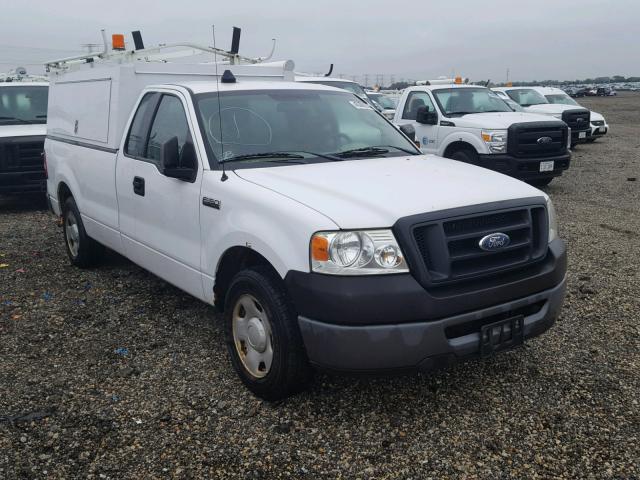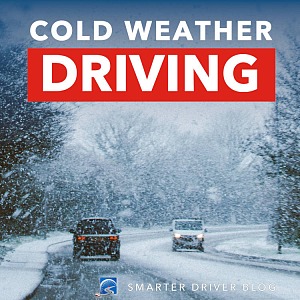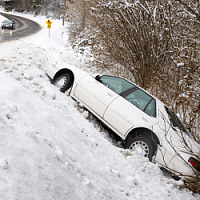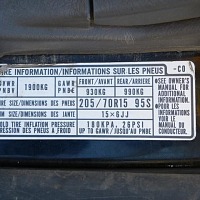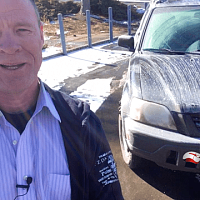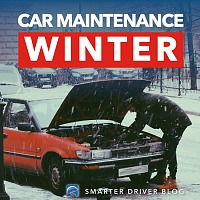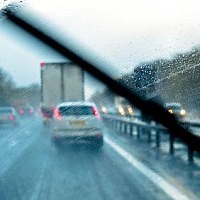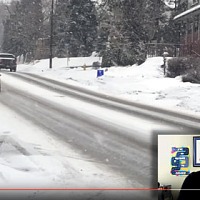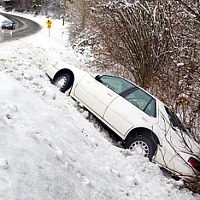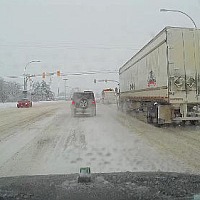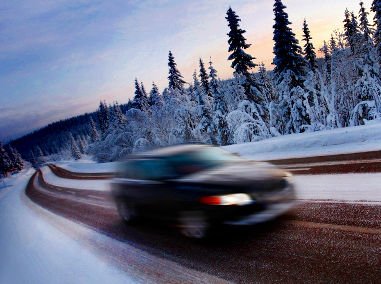Learn the top 5 reasons for crashing in winter - watch the video.
Top 5 Winter Driving Tips to Prevent Icy Roads Accidents
Closed Caption
Introduction
Hi there smart drivers Rick with Smart Drive Test talking to you today about five reasons--five reasons--why you will crash in the winter time and end up in the ditch, and hopefully not die in a fiery Inferno.
And one of those reasons is not speed.

We'll tell you that at the end of the video.
Stick around, we'll be right back with that information.
[INTRO & MUSIC]
[DISCLAIMER - IF YOU SEE YOUR VIDEO HERE, PLEASE CONTACT US FOR CREDIT]
Hi there smart drivers.
Welcome back.
Rick with Smart Drive Test talking to you today about five reasons that you will crash in the winter time.

Smart Drive Test helps new drivers get their first license regardless of class.
And as well it helps veteran drivers to remain crash free and improve their driving skills.
So if you're new here, hit that subscribe button.
As well hit, that bell, that way you'll get instant notification when I get the videos up for you.
#1 :: Not Paying Attention
Reason number one for crashing in the wintertime is not paying attention.
Not paying attention to the weather reports, not paying attention to the fact that it's around zero (0°C or 32°F).
It has been raining or snowing or some other precipitation that's going to cause the roads to be slick and slippery.
And there's going to be ice on the roadways.

And yes, some authorities and other people believe that it's called "black ice" but there are reasons that you can find black ice - ice on the roadways.
And I'll put a card up here for you for where you can find ice on the roadways in the winter time.
But you can see also that I am susceptible to going for a slide as you can see here in the video footage of getting in a hurry in the morning, not allowing myself enough time and getting caught out at an intersection and having the vehicle skid.
So one of the things that we have to do in the winter time is, even though we're crazy busy, and we're trying to herd our children out the door, or get out to go to work, or wherever we're going.
We need to allow ourselves a little bit more time to pay attention:
- to the weather report;
- the fact that the temperature is around freezing;
- there's some form of precipitation.
And know that at intersections - these are going to be incredibly slippery because what happens is the vehicles come up, they brake, they slide.
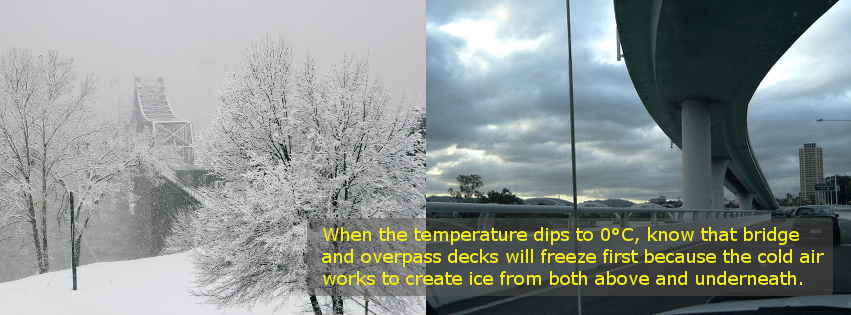
And when the vehicles tires slide on top of the snow or ice, it creates friction, which the byproduct is heat.
It melts the snow a little bit and you get a layer of water on top of the ice and it makes it incredibly slippery.
Think of a Zamboni after it's just flooded and cleaned the ice hockey rink.
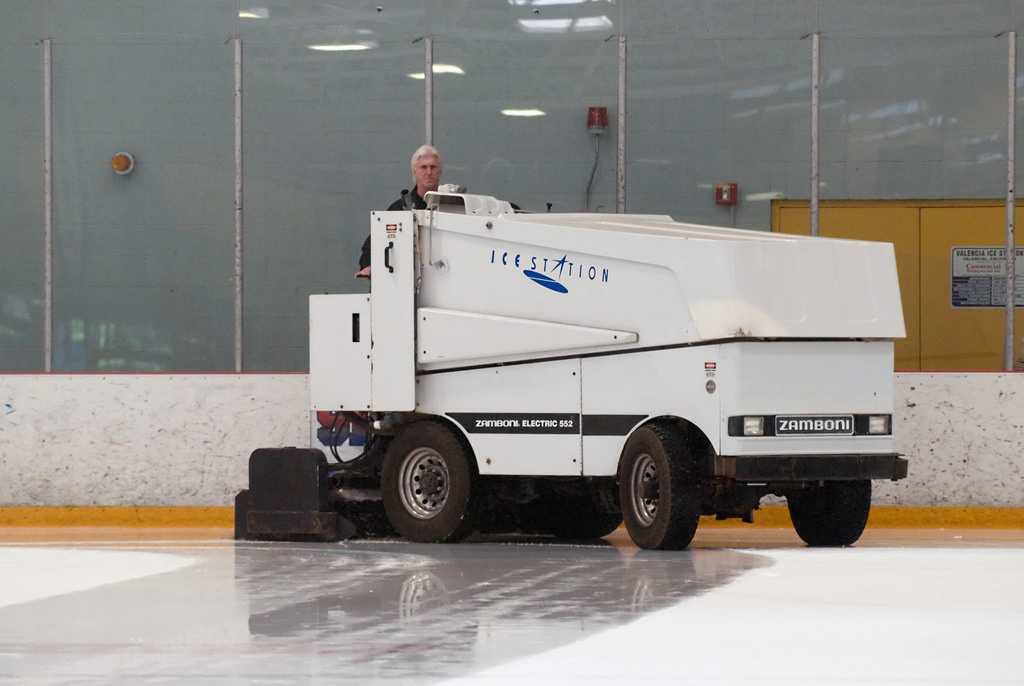
#2 :: Too Fast on Curves & Corners
Reason number two for getting into a skid are curves and getting the vehicle out of line.
Any time that the vehicle moves out of line, you're going to be in a precarious situation.
Especially if the roadways are slippery and your speed is too high as you can see here in many of the crash videos that you watch here on the internet.
What happens is they're going around a curve, the backend comes around, and it's called oversteering.
It's what happens when the backend of the vehicle comes around because the vehicles momentum shifts to the front of the vehicle and the backend starts to come around.
So curves, corners and turns.
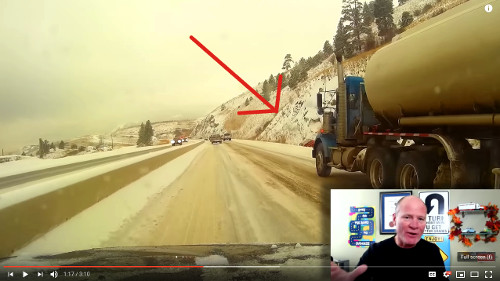
You can also see here in passing, that a lot of drivers lose control when they're passing.
Because what happens is the vehicle goes from being straight down the road to being on a slight angle.
And when the vehicle is on a slight angle you've shifted the momentum or the equilibrium in the vehicle, and because you've shifted the equilibrium, you're gonna lose control of the vehicle and end up in the ditch.
#3 :: Pickup Truck Phenomena
Reason number three for ending up in the ditch and having a crash in the winter time is what I call the "pickup truck phenomena."
It's the imbalance of the weight in the vehicle and its most common with pickup trucks because all the weight is in the front of the vehicle and the drive tires are at the back.
But this is also applicable to minivans and SUVs and other types of vehicles where most of the weight is on the front end.
Especially if you have the motor and the drivetrain and other bits in the front and you're going down the road and the speed in combination with going around a curve it causes the backend of the vehicle to lift up and again you get over-steering and you lose control of the vehicle.
#4 :: Too Much Brake (A Locked or Spinning Wheel)
Reason number four is in combination with the pickup phenomena, which is brakes.
And what happens is that as soon as the vehicle starts to lose traction the driver gets on the brakes.
And what happens is the brakes accentuates both the pickup phenomena and the curve phenomena, because what happens is that you hit the brakes, the front end of the vehicle tips down, you shift all the weight of the vehicle into the front of the vehicle, the back end lifts up loses traction and starts to come around.
And remember the reason that we lose control in the vehicle is because "a lock or spinning wheel always leads!"
So as soon as you get your foot on the brake in slippery conditions and the back wheels lock up or the wheels lock up period, it loses traction.
Because it's already slippery - all the weight comes off the back end because you've shifted the momentum to the front of the vehicle and the vehicle starts to go around in a circle.
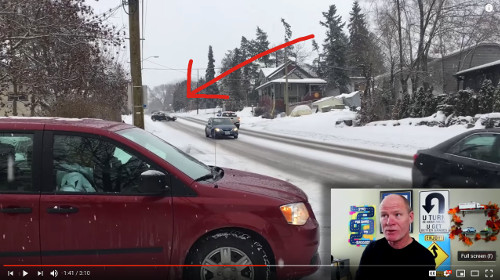
So a locked and spinning wheel always leads.
So get your foot off the brake, look in the direction that you want to go.
I know that there are other channels here and those types of things and people who will tell you steer in the direction of the skid, which always reminds me of Bill Cosby's comedy skit, when he's talking about that and he goes into a skid and he's slowing time down and trying to remember which way is the skid.
Do you know: "is it going to the right, or is it going to the left?"
No, don't try and figure that out.
Just look in the direction you want to go and steer the vehicle.
And do not oversteer.
Simply quarter turns on the steering wheel, will get you usually back to where you need to go.
But if you touch the brake, that's almost certain loss of control in the event of hitting something slippery.
#5 :: Hills & Gravity
And reason number five is hills.
If you get going down the hill and you start losing traction and losing control, most people panic.
You can see this in most of the videos, where we get ice or freezing rain and the roadway becomes an absolute skating rink and people just hold the brake.
Essentially what you're doing when you hold that brake on is "hoping and praying" that the vehicle is going to stop and you are just riding a wild animal.
That vehicle is going to go anywhere it chooses to go.
It's gonna run into items and all kinds of objects and fixed objects and other vehicles and those types of things along the roadway.
Because you've locked up the wheels, the vehicle is not going to stop.
So you have to get the vehicle off the roadway somehow and find traction, whether that's into the gravel on the side of the road or whether that's off into the snow or whatnot.
You need to get the vehicle somewhere else because you're not going to get it stopped on ice especially if you're going downhill.

And in order to do that, in order to be able to steer the vehicle you've got to get your foot off the brake and let the wheels spin.
Because if the wheels aren't turning the vehicle is not going to be able to steer.
So if you've got your foot on the brake it's not going to steer - you're just driving a juggernaut.
So do something, figure something out figure out, where are you going to steer the vehicle and those types of thing.
Again get your foot off the brake.
I know it's gonna pick up speed, but you got to pick a point, you got to pick out some where you're gonna go and pick that small object to hit as opposed to the big object to hit, like the tractor-trailer for example, and those types of things.
Bonus :: Speed & Speeding
Now I said at the beginning of the video: speed was not a criteria in any one of these crashes.
It's not one of the factors, but it does contribute to all of these crashes because most of the time people are going too fast for the conditions of the road.
Because speeding... the definition of speeding is not simple.
There are several definitions of speeding:
• driving faster than the flow of traffic;
• driving faster than me, for example.
You're sitting in the car and somebody passes you, "Oh my god, they're speeding!" because they're going faster than me.
• Or driving faster than the conditions of the roadway allow.
And how do we determine how fast is too fast?

So speeding is a complex definition and it doesn't lend itself to just one definition.
But it does tie into all of these and contributs to all of these crashes.
And know for a fact that you need to slow down in the winter time.
And the other comment is that winter tires will save you in the winter time.
No winter tires won't save you.
It's this one person said on one channel I was looking at.
If you're doing 100 mph (160km/hr) in the winter time with snow tires, it's not going to save you.
So you have to drive to the conditions of the roadway.
Otherwise all these factors are going to be exacerbated by speeding for the conditions.
But most important you have to pay attention, you have to take note of the weather outside, and you have to slow down.
Otherwise you're going to end up in a crash and you're going to end up in the ditch.
Question for my smart drivers:
Do you have any tips that you would give to smart drivers to help them make it through the winter crash free?
Leave a comment down in the comment section there.
All of that helps out the new drivers and the veteran drivers looking to improve his or her skills.
If you like what you see here share, subscribe, leave a comment down in the comment section.
As well, hit that thumbs up button.
Look down in the description there and get the thirty percent off coupon for "PASS your road test first time."
It's a course for new drivers guaranteed PASS you road test first time or 60-day money-back guarantee.
As well, head over to the Facebook Smart Drive Test page.
We have a mastermind group for drivers to get together and share their information, share their knowledge about passing a road test first time or staying crash free, especially in the wintertime.
This week I posted a video about a truck crash and asked for the reasons why that happened.
After watching this video you should be able to figure out all the reasons why the truck crashed.
So click the link down in the description there and head over to the Facebook page and join our Mastermind group.
I'm Rick with Smart Drive Test.
Thanks very much for watching.
Good luck on your road test.
And remember, pick the best answer not necessary the right answer.
Have a great day.
Bye now.
BLOOPER
[BLOOPER - TALKING TO SON OFF CAMERA] "Get out of there! You're gonna drop something and make noise you cretin!

